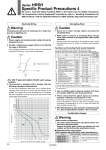
es40-57-hrsh 35 / 37
10秒後にBOOKのページに移動します
Circulating Fluid Caution 1. Avoid oil or other foreign objects entering the circulating fluid. 2. When water is used as a circulating fluid, use tap water that conforms to the appropriate water quality standards. Use tap water that conforms to the standards shown below (including water used for dilution of ethylene glycol aqueous solution). Tap Water (as Circulating Fluid) Quality Standards The Japan Refrigeration and Air Conditioning Industry Association JRA GL-02-1994 “Cooling water system . Circulation type . Make-up water” Item Unit Standard value Influence Corrosion Scale generation Standard item pH (at 25°C) . 6.0 to 8.0 v v Electric conductivity (25°C) [mS/cm] 100* to 300* v v Chloride ion (Cl.) [mg/L] 50 or less v Sulfuric acid ion (SO4 2.) [mg/L] 50 or less v Acid consumption amount (at pH4.8) [mg/L] 50 or less v Total hardness [mg/L] 70 or less v Calcium hardness (CaCO3) [mg/L] 50 or less v Ionic state silica (SiO2) [mg/L] 30 or less v Reference item Iron (Fe) [mg/L] 0.3 or less v v Copper (Cu) [mg/L] 0.1 or less v Sulfide ion (S2 .) [mg/L] Should not be detected. v Ammonium ion (NH4 +) [mg/L] 0.1 or less v Residual chlorine (Cl) [mg/L] 0.3 or less v Free carbon (CO2) [mg/L] 4.0 or less v * In the case of [MΩ・cm], it will be 0.003 to 0.01. v: Factors that have an effect on corrosion or scale generation. Even if the water quality standards are met, complete prevention of corrosion is not guaranteed. 3. Use an ethylene glycol aqueous solution that does not contain additives such as preservatives. 4. When using ethylene glycol aqueous solution, maintain a maximum concentration of 15%. Overly high concentrations can cause a pump overload. Low concentrations, however, can lead to freezing when circulating fluid temperature is 10°C or lower and cause the thermo-chiller to break down. 5. When deionized water is used, the electric conductivity should be 1 μS/cm or higher (Electric resistivity: 1 MW・cm or lower). Facility Water Supply Warning